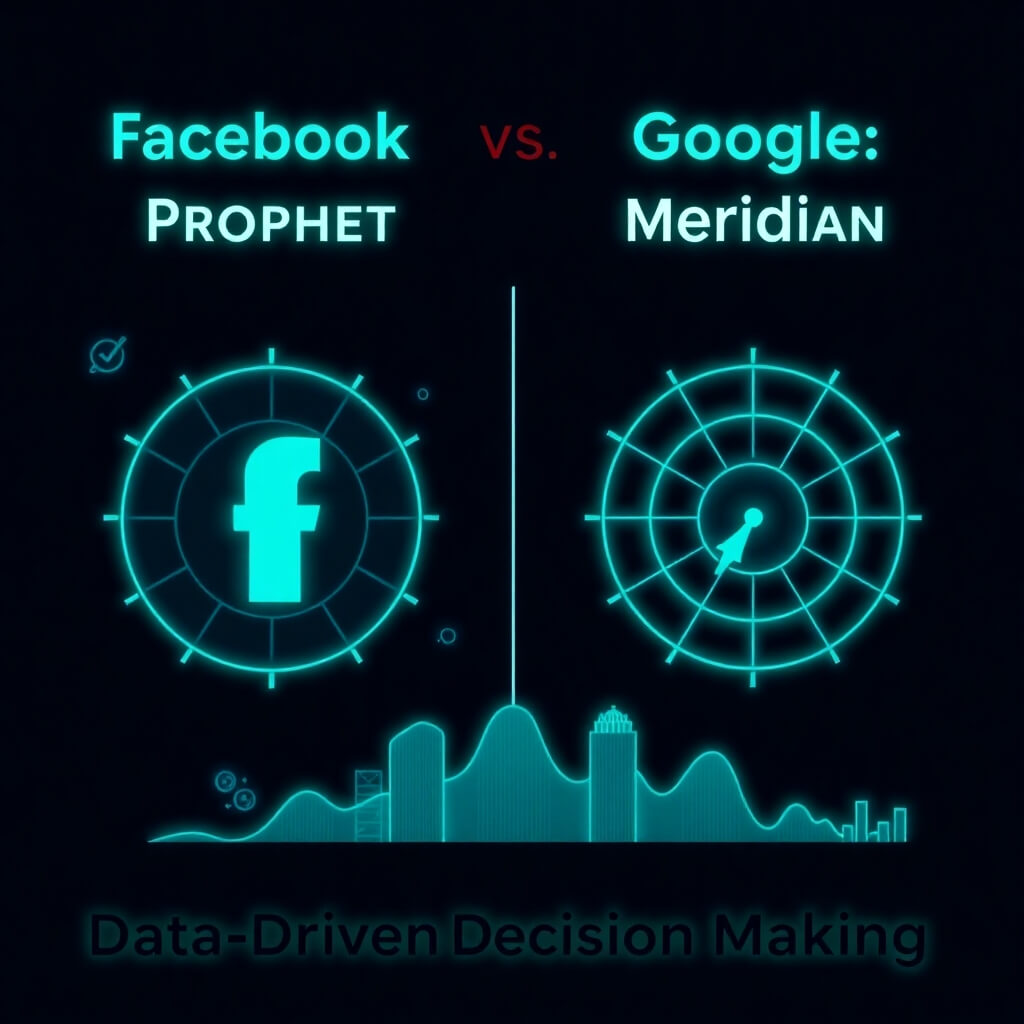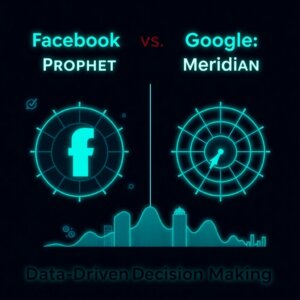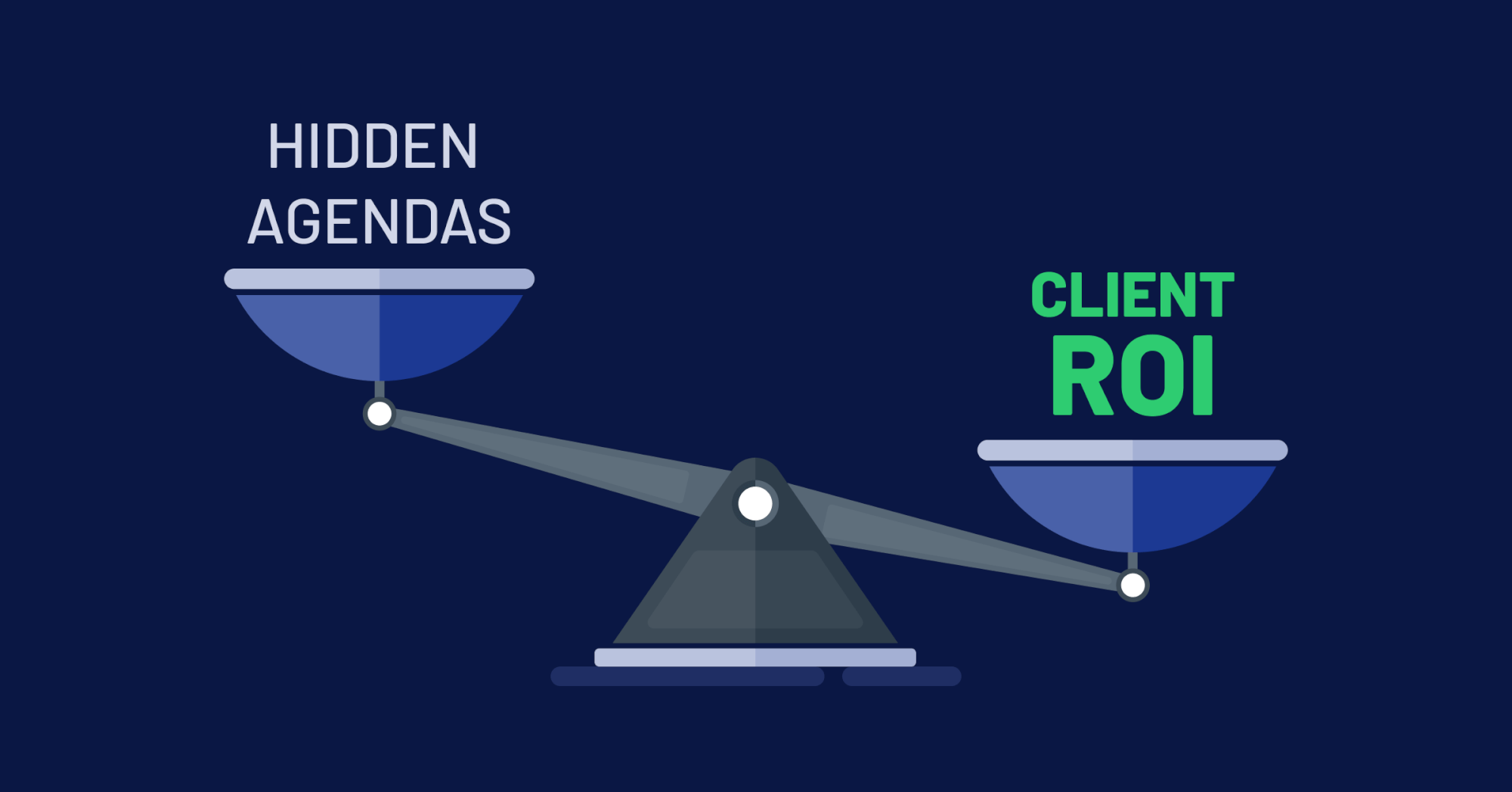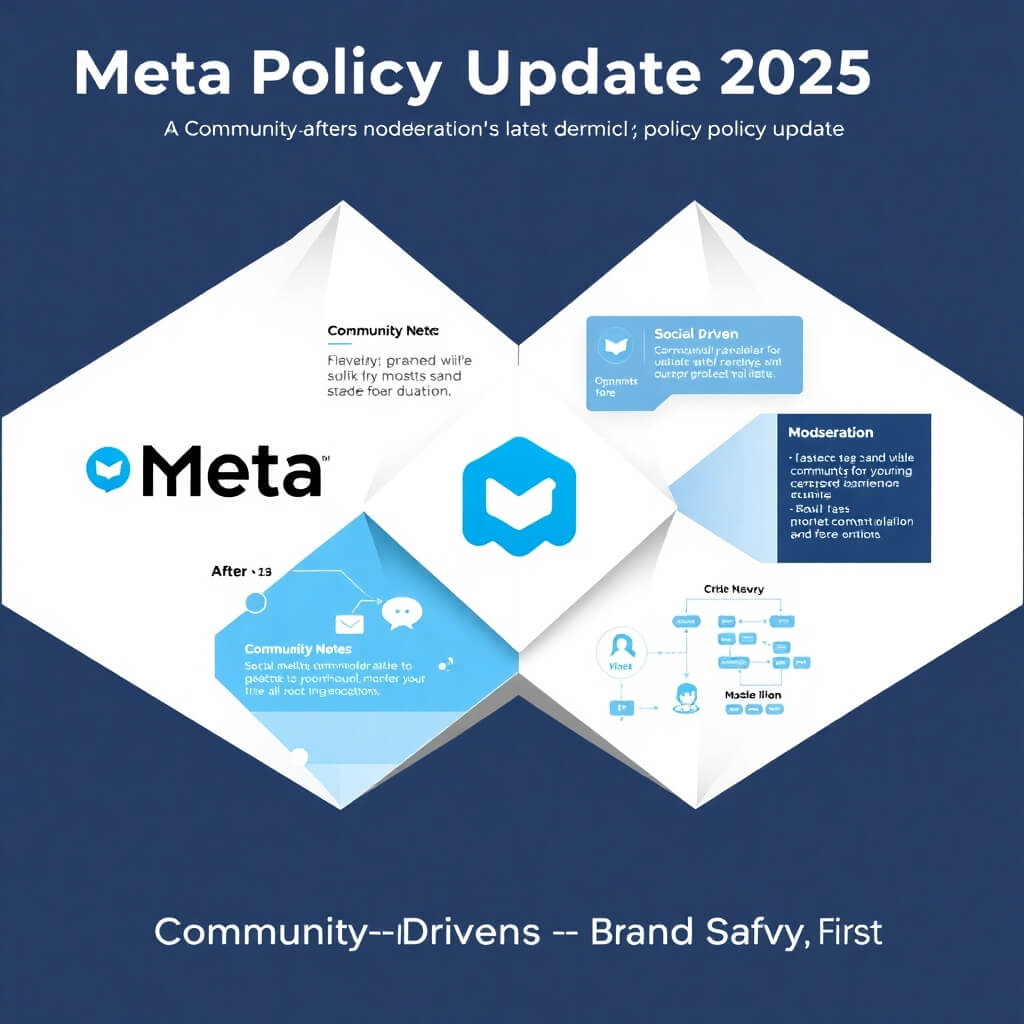

Media Mix Modeling
Introduction to Media Mix Modeling
Media mix modeling (MMM) has become an indispensable tool for optimizing advertising spend and maximizing return on investment (ROI). By leveraging historical data, businesses can analyze how different marketing channels—such as paid search, social media, programmatic display, and traditional media—contribute to sales, engagement, and brand awareness. However, to build an effective media mix model, accurate and reliable time-series forecasting is required.
Two of the most powerful tools available for time-series forecasting are Facebook Prophet and Google Meridian. Both tools provide valuable insights into future trends, but they are built on fundamentally different principles. Prophet is designed for ease of use, making it accessible to marketing analysts and business professionals who need quick, interpretable forecasts. Google Meridian, in contrast, takes a Bayesian probabilistic approach, offering greater flexibility and more nuanced uncertainty modeling, making it ideal for complex datasets where traditional forecasting methods fall short.
This article explores the strengths, weaknesses, and applications of these two forecasting tools within the context of media mix modeling, highlighting how businesses can leverage them to make data-driven decisions. Additionally, we will examine how Jupyter Notebooks serve as an essential platform for implementing, testing, and refining these models.
Overview of Facebook Prophet & Google Meridian
A. Understanding Facebook Prophet
Facebook Prophet is an open-source time-series forecasting tool developed by Meta (formerly Facebook) to help businesses and analysts make quick and accurate predictions. The tool is designed to automatically identify trends, seasonality, and special event effects without requiring extensive manual tuning. It is widely used in business forecasting applications, including marketing analytics, demand forecasting, and sales prediction.
One of Prophet’s key advantages is its additive model, which breaks down time-series data into three main components:
- Trend: The overall increase or decrease in data over time.
- Seasonality: Repeating patterns that occur daily, weekly, or yearly.
- Holidays & Events: Special occurrences that cause temporary spikes or drops in performance.
Prophet is particularly useful for media mix modeling, as it allows marketers to predict future ad performance based on historical trends. Its ease of use makes it a popular choice among business analysts, marketing managers, and data teams who need reliable forecasts without requiring in-depth knowledge of machine learning or statistical modeling.
B. Understanding Google Meridian
Google Meridian is an advanced forecasting tool that takes a probabilistic approach to time-series predictions. Unlike Prophet, which provides single-point forecasts with confidence intervals, Meridian generates full probability distributions, making it more effective for modeling uncertainty. This makes it ideal for applications where risk assessment and variability are key concerns.
In media mix modeling, advertising performance is often unpredictable. Factors such as consumer behavior shifts, algorithm changes, and economic fluctuations can lead to sudden changes in marketing effectiveness. Traditional forecasting methods may fail to account for this level of uncertainty, leading to overconfident predictions. Meridian addresses this issue by using Bayesian inference and Gaussian Processes to provide a more realistic view of future outcomes.
Google Meridian is best suited for organizations that require highly flexible and customizable forecasting models, particularly for marketing attribution, probabilistic budget planning, and complex marketing datasets. However, its advanced capabilities come with a steeper learning curve and require a strong understanding of statistical modeling principles.
Understanding Google Meridian: A Probabilistic Approach to Forecasting
Google Meridian is a probabilistic forecasting tool that uses Bayesian inference and Gaussian Processes to model uncertainty in time-series data. Unlike Prophet, which provides point estimates with confidence intervals, Meridian generates full probability distributions, allowing marketers to quantify risk and assess a range of possible outcomes.
A. How Google Meridian Works
Meridian is based on Bayesian statistical methods, which update predictions as new data becomes available. This is particularly valuable in dynamic marketing environments where advertising effectiveness fluctuates due to external factors such as algorithm changes, economic conditions, and consumer sentiment shifts.
Rather than assuming a fixed trend, Meridian models uncertainty directly, providing businesses with the ability to make risk-aware decisions. This makes it especially useful for media mix modeling, where different marketing channels interact in complex ways, and traditional forecasting methods often fail to capture these dependencies.
B. Why Google Meridian is Ideal for Media Mix Modeling
Meridian is particularly well-suited for media mix modeling when:
- Marketers need to assess the probability of different campaign outcomes, especially in uncertain environments.
- Budget allocation must account for risk and volatility (e.g., shifting spend between Google Ads, Facebook Ads, and TikTok campaigns).
- Complex dependencies exist between marketing channels, such as how TV ads influence organic search traffic.
For example, a company running a multi-channel campaign across search, display, and social media might want to predict the impact of a 20% budget increase on overall conversions. Using Meridian, they can generate a range of possible outcomes, helping them determine whether the additional investment is justified given the associated risk.
C. Key Strengths of Google Meridian
- Probabilistic Forecasting – Generates full probability distributions rather than single-point estimates.
- Advanced Customization – Allows users to define priors, kernel functions, and uncertainty models.
- Models Complex Dependencies – Captures interactions between different marketing channels.
- Handles High Variability – More resilient to noisy and unpredictable data.
- Risk-Aware Decision-Making – Enables marketers to assess worst-case and best-case scenarios.
D. Limitations of Google Meridian
While powerful, Meridian also has some key limitations:
- Steep Learning Curve – Requires knowledge of Bayesian inference and probability theory.
- Computationally Intensive – More resource-intensive than Prophet, requiring greater processing power.
- Less Adoption & Community Support – Compared to Prophet, Meridian has fewer tutorials and online resources.
Understanding Facebook Prophet: An Additive Approach to Forecasting
Facebook Prophet is an open-source forecasting tool developed by Meta (formerly Facebook) to make time-series predictions more accessible to non-experts. It was designed specifically to handle the challenges of real-world business forecasting, including missing data, outliers, and irregular time series. Prophet is built on an additive model, meaning that it decomposes a time series into three primary components:
- Trend – The underlying direction of the data over time, which can be linear or logistic.
- Seasonality – Recurring patterns that occur daily, weekly, or yearly, capturing predictable fluctuations in data.
- Holiday Effects – Special events such as Black Friday, Christmas, or Super Bowl campaigns that introduce temporary deviations in marketing performance.
A. How Facebook Prophet Works
Prophet uses a generalized additive model (GAM), a type of regression model that is flexible and robust for capturing trends and seasonality. It allows users to specify changepoints, which are points in time where the trend shifts—critical for marketing applications where consumer behavior often changes due to external factors.
The tool is designed for automatic parameter tuning, meaning it can optimize forecasting parameters without requiring extensive manual input. This makes Prophet especially useful for marketing analysts and business professionals who need to generate quick, interpretable forecasts without deep statistical expertise.
B. Why Facebook Prophet is Ideal for Media Mix Modeling
For media mix modeling, Prophet is well-suited for situations where:
- Marketing trends follow consistent, seasonal patterns (e.g., holiday sales, back-to-school campaigns).
- Marketers need a fast and interpretable forecasting model without extensive customization.
- Data quality is inconsistent and may include missing values or outliers.
For example, an e-commerce company using Google Ads and Facebook Ads might want to forecast how their cost per acquisition (CPA) changes seasonally. With Prophet, they can input historical CPA data and obtain a reliable forecast that accounts for past trends and upcoming seasonal fluctuations.
C. Key Strengths of Facebook Prophet
- Ease of Use – Designed for business users, requiring minimal statistical expertise.
- Handles Missing Data and Outliers – Automatically adjusts for inconsistencies in data.
- Interpretable Outputs – Produces clear trend lines, seasonal patterns, and confidence intervals.
- Optimized for Seasonal Marketing Data – Ideal for businesses with recurring marketing cycles.
- Fast Computation – Can quickly generate forecasts for real-time decision-making.
D. Limitations of Facebook Prophet
Despite its strengths, Prophet has some notable limitations when used for media mix modeling:
- Limited Ability to Model Complex Dependencies – Cannot fully capture interactions between different marketing channels.
- Not Fully Probabilistic – While Prophet provides uncertainty intervals, it does not generate full probability distributions like Bayesian models.
- Struggles with Highly Volatile Data – Does not handle abrupt changes in trends well, such as sudden shifts in consumer behavior due to major market disruptions.
These limitations mean that for advanced MMM applications, where uncertainty modeling and multi-channel interactions are critical, Google Meridian may be a better choice.
Strengths of Facebook Prophet in Media Mix Modeling
One of the key advantages of Facebook Prophet is its ease of implementation. Marketers who are not data scientists can quickly learn to use Prophet and generate forecasts with only a few lines of code. The tool’s intuitive interface allows business users to focus on interpreting the results rather than dealing with complex statistical calculations.
A major benefit of Prophet is its ability to automatically detect and account for trends and seasonality. In the context of media mix modeling, this is particularly useful for businesses that experience recurring fluctuations in advertising performance due to holidays, weekends, or annual sales events. For example, an e-commerce company may notice that ad performance spikes during Black Friday and Cyber Monday but declines in January. Prophet can incorporate these patterns into its forecasts, helping marketers plan their budget allocations accordingly.
Prophet also excels in handling missing data and outliers, which is essential in marketing analytics. Many digital marketing datasets are incomplete or inconsistent due to tracking errors, attribution issues, or external disruptions. Prophet automatically adjusts for these inconsistencies, ensuring that forecasts remain reliable even when the input data is not perfect.
Another strength of Prophet is its fast computation speed, which makes it ideal for real-time decision-making. For marketing teams that need to adjust their advertising budgets on a weekly or even daily basis, the ability to generate quick forecasts without extensive processing time is a major advantage.
Strengths of Google Meridian in Media Mix Modeling
While Facebook Prophet provides a simple and efficient approach to forecasting, Google Meridian offers a more advanced and flexible solution for media mix modeling. One of the biggest advantages of Meridian is its probabilistic forecasting capabilities. Rather than generating a single-point estimate, Meridian produces a range of possible future outcomes, allowing marketers to quantify uncertainty and assess the risk associated with different marketing strategies.
This probabilistic approach is particularly valuable when dealing with highly volatile advertising performance, such as social media campaigns that can suddenly go viral or underperform due to algorithm changes. By using Bayesian inference, Meridian enables marketers to account for multiple scenarios, ensuring that their budget allocation strategies remain resilient to uncertainty.
Another key strength of Meridian is its ability to model complex dependencies between different media channels. In traditional media mix models, advertising channels are often treated as independent variables, but in reality, they interact and influence one another. For example, an increase in TV advertising may lead to a surge in organic search traffic, or a successful email campaign might boost social media engagement. Meridian’s Bayesian modeling framework allows for a more holistic understanding of these interactions, leading to more accurate marketing attribution.
However, the advanced capabilities of Meridian come with increased computational complexity. Running probabilistic models requires more processing power and expertise, making it less accessible to business users who are not familiar with statistical modeling.
Choosing the Right Forecasting Tool for Media Mix Modeling
Both Facebook Prophet and Google Meridian offer powerful forecasting capabilities, but they cater to different needs within media mix modeling.
Facebook Prophet is the best choice for marketers who need quick, reliable forecasts without deep technical expertise. It is ideal for seasonal marketing trends, budget planning, and straightforward advertising performance predictions.
Google Meridian, on the other hand, is better suited for advanced data scientists and analysts who require probabilistic forecasting and risk-aware decision-making. It excels in complex marketing attribution models, uncertain budget planning, and volatile campaign performance analysis.
Regardless of which tool is used, Jupyter Notebooks provide an essential environment for running, testing, and documenting forecasts. By leveraging the interactive features of Jupyter, marketing teams can create dynamic, data-driven forecasting models that drive better marketing decisions.
When to Use Facebook Prophet vs. Google Meridian for Media Mix Modeling
Facebook Prophet is the best choice for marketers who need fast, interpretable forecasts and are working with structured, seasonal data. It is ideal for business analysts, marketing managers, and teams without deep statistical expertise.
Google Meridian, on the other hand, is better suited for data scientists and advanced analysts who need a fully probabilistic model that can handle high uncertainty and complex interactions between marketing channels.
Ultimately, the choice between Prophet and Meridian depends on the complexity of the media mix model, the level of statistical expertise within the team, and the need for uncertainty modeling. Businesses that require quick, actionable insights will benefit from Prophet, while those looking for more advanced risk modeling and attribution analysis will find Meridian to be a more powerful tool.
| Feature | Facebook Prophet | Google Meridian |
| Description | Open-source tool for time-series forecasting developed by Meta (formerly Facebook). | Open-source library for probabilistic time-series forecasting by Google. |
| Primary Use Case | Forecasting time-series data with trends, seasonality, and holidays. | Probabilistic time-series forecasting with a Bayesian approach. |
| Core Algorithm | Uses an additive model combining trend, seasonality, and holidays with piecewise linear or logistic growth. | Uses Bayesian inference and Gaussian Processes for probabilistic forecasting. |
| Approach | Deterministic forecasting with uncertainty estimation. | Fully probabilistic forecasting model. |
| Ease of Use | User-friendly with automatic tuning; good for business and non-expert users. | More flexible but requires knowledge of probabilistic models. |
| Customization | Allows specifying seasonal effects, change points, and external regressors. | Allows advanced customization of priors, kernel functions, and uncertainty modeling. |
| Strengths | Easy to implement, interpretable forecasts, handles missing data and outliers well. | Provides a full probability distribution for forecasts, making it useful for risk modeling. |
| Limitations | Less flexible in modeling complex dependencies and correlations. | Requires a deeper understanding of Bayesian statistics and computational resources. |
| Programming Languages | Python, R. | Python. |
| Installation | pip install prophet | pip install meridian (or from GitHub) |
| Official Documentation | Prophet Docs | Meridian Docs |
| GitHub Repository | GitHub – Prophet | GitHub – Meridian |
Using Jupyter Notebooks for Facebook Prophet and Google Meridian
Introduction to Jupyter Notebooks
What is Jupyter Notebook?
Jupyter Notebooks are interactive computing environments that allow users to write and execute live Python code while incorporating text, visualizations, and other media. They are widely used in data science, machine learning, and analytics due to their flexibility and ease of use.
For time-series forecasting with Facebook Prophet and Google Meridian, Jupyter Notebooks provide an ideal platform by enabling incremental execution, real-time visualization, and detailed documentation of the forecasting process.
Why Jupyter Notebooks are Ideal for Forecasting?
Jupyter Notebooks make it easier to:
- Write and Run Code in Chunks – Unlike traditional scripts, Jupyter allows users to execute specific sections (cells) of code without running the entire script, making debugging and model iteration faster.
- See Immediate Results – The output, including graphs, tables, and probability distributions, appears directly below the code that generates it.
- Modify and Rerun Code Efficiently – Users can tweak parameters and rerun only the necessary portions without restarting the entire notebook.
- Visualize Data in Real-Time – Both Prophet and Meridian produce graphical outputs, and Jupyter Notebooks seamlessly display these forecasts inline.
- Create Shareable Reports – Users can add explanatory text using Markdown, making it easy to create documentation alongside code for presentations, research, or collaboration.
Using Jupyter Notebooks for Facebook Prophet
Setting Up Prophet in Jupyter Notebook
To use Facebook Prophet within a Jupyter Notebook, users must first install the necessary libraries. This is done by running the following commands in a notebook cell:
Loading and Preparing Data
Prophet requires a dataframe with two specific columns:
- ds (datetime) – The timestamp for each observation.
- y (value) – The numerical value being forecasted (e.g., conversions, ad spend, website traffic).
Example dataset loading:
Building a Forecasting Model in Jupyter Notebook
Once the data is loaded, the Prophet model can be initialized and trained within a few lines of code:
Visualizing Forecasts in Jupyter Notebook
One of the key benefits of using Jupyter Notebooks is inline visualization, which allows users to immediately see the forecasting results:
Jupyter’s interactive capabilities make it easy to tweak parameters, add seasonal adjustments, and compare different forecasting scenarios within the same document.
Adding Seasonal and Holiday Adjustments
Since media mix modeling often involves seasonal trends and special events, users can enhance Prophet’s accuracy by adding known holidays:
Using Jupyter Notebooks for Google Meridian
Setting Up Google Meridian in Jupyter Notebook
Unlike Prophet, Google Meridian is a probabilistic forecasting tool that requires additional statistical setup. The first step is to install and import the necessary libraries:
Loading and Preprocessing Data for Meridian
Meridian works with time-series data similar to Prophet, but instead of just predicting a single trend, it models uncertainty and probability distributions.
Building a Probabilistic Forecast in Jupyter Notebook
Unlike Prophet, which assumes an additive model, Meridian applies Bayesian inference to generate multiple possible future paths:
Visualizing Probabilistic Forecasting Results
Meridian produces probability distributions instead of single-point estimates, making visualization critical:
The ability to see multiple possible future scenarios makes Meridian especially useful for media mix modeling, where marketers need to account for uncertainty in marketing spend and ROI.
Customizing Priors and Uncertainty Models in Meridian
Meridian allows users to customize priors and kernel functions to better reflect uncertainty in marketing data:
Why Jupyter Notebooks are Essential for Prophet & Meridian
Both Facebook Prophet and Google Meridian benefit from Jupyter Notebooks’ interactive and visual capabilities, making forecasting workflows more efficient and transparent.
Key Advantages of Jupyter for Time-Series Forecasting
- Incremental Execution – Users can run specific parts of the forecasting pipeline without restarting the entire process.
- Immediate Feedback – Forecasts are generated and visualized instantly, allowing for quick adjustments.
- Interactive Visualizations – Users can analyze trends, seasonal effects, and probabilistic distributions side by side.
- Markdown Documentation – Analysts can document insights, annotate visualizations, and create shareable reports without needing separate files.
- Experimentation & Comparison – Different forecasting models can be tested within the same notebook, making Prophet vs. Meridian comparisons easy.





